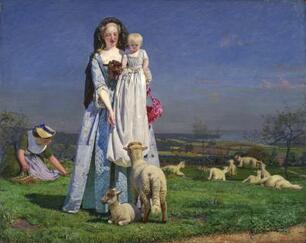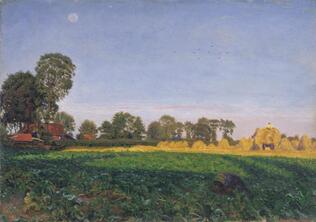Ford Madox Brown was born at Calais and studied in Antwerp and Paris before settling in London in 1844 after his mother's death in 1839, his sister's in 1840 and then his father in 1842. He first exhibited at the Royal Academy in 1840. A growing interest in painting subjects in daylight was deepened by a visit to Italy in 1845-6. In addition to losing all of his immediate family before moving to London, he had a difficult family life with his first wife dying young, his second wife becoming an alcoholic and four of his children dying young. During the 1860s, Brown also designed furniture and stained glass and in 1861 became a founder partner of William Morris's design company, Morris, Marshall, Faulkner & Co., which dissolved in 1874 with Morris continuing on his own.
Brown was close to the Pre-Raphaelite Brotherhood but was never a member of the group.
Brown was close to the Pre-Raphaelite Brotherhood but was never a member of the group.
The following paintings by Brown were in the collection of BG Windus.
There may be other paintings which have not as yet been connected with the Windus Collection.
There may be other paintings which have not as yet been connected with the Windus Collection.
|
The Last of England, known as the Last Sight of England Two emigrants, the man holding an umbrella, and his wife carrying a baby, seated on board ship. A crowd of figures beyond; in the background a rough sea and distant cliffs. Brown was inspired by the great emigration movement which culminated in 1852. The two principal figures are portraits of Madox Brown and his second wife, Emma. Sale of the painting, and the cartoon, to BG Windus ended Brown's notions of emigrating to India. © Birmingham Museums & Art Gallery |
|
The Pretty Baa-Lambs In 'Pretty Baa-lambs' Brown posed his models outdoors, wanting to depict on canvas the effect of bright sunlight exactly as he found it in nature. According to Holman Hunt: ‘The picture of “Pretty Baa Lambs” painted by Brown in summer of 1851 was strictly the first figure picture he had done in the open air . . . painted with unprecedented care for the landscape, with the sky serving as the ceiling of our studio’. © Ashmolean Museum, University of Oxford |
|
The Brent at Hendon Brown started the painting in September 1854 and shortly afterwards began work on Carrying Corn at the same time. He wrote in his journal 'nature that at first sight appears so lovely is on consideration almost always incomplete, moreover there is no painting intertangled foliage without losing half its beauties'. The figure reading under a tree on the left of the painting is his wife, Emma. © Tate |
|
Carrying Corn Inspired by a view of a turnip field on a bus ride from north London to St Albans, Brown set out to capture that intense moment. He visited his chosen site around 21 times, spending 70 hours painting. He recorded his exasperation with the changing weather and activity and noting that by his last visit he was 'sick of it'. The painting was rejected for the 1855 Royal Academy exhibition. © Tate |
|
The First Translation of the Bible into English (Wycliffe Reading His Translation of the New Testament to His Protector, John of Gaunt, Duke of Lancaster, in the Presence of Chaucer and Gower, His Retainers) John Wycliffe was an English theologian, philosopher, church reformer and promoter of the first complete translation of the Bible into English. The translations appeared over a period from approximately 1382 to 1395. Although unauthorised, the work was popular. © Bradford Art Galleries and Museums |





